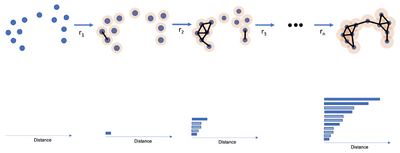Persistence barcode
In topological data analysis, a persistence barcode, sometimes shortened to barcode, is an algebraic invariant of a persistence module that characterizes the stability of topological features throughout a growing family of spaces.[1] Formally, a persistence barcode consists of a multiset of intervals in the extended real line, where the length of each interval corresponds to the lifetime of a topological feature in a filtration, usually built on a point cloud, a graph, a function, or, more generally, a simplicial complex or a chain complex. Generally, longer intervals in a barcode correspond to more robust features, whereas shorter intervals are more likely to be noise in the data. A persistence barcode is a complete invariant that captures all the topological information in a filtration.[2] In algebraic topology, the persistence barcodes were first introduced by Sergey Barannikov in 1994 as the "canonical forms" invariants[2] consisting of a multiset of line segments with ends on two parallel lines, and later, in geometry processing, by Gunnar Carlsson et al. in 2004.[3]
Definition
Let be a fixed field. Then a persistence module indexed over consists of a family of -vector spaces and linear maps for each such that for all .[4] This construction is not specific to ; indeed, it works identically with any totally-ordered set.

A persistence module is said to be of finite type if it contains a finite number of unique finite-dimensional vector spaces. The latter condition is sometimes referred to as pointwise finite-dimensional.[5]
Let be an interval in . Define a persistence module via , where the linear maps are the identity map inside the interval. The module is sometimes referred to as an interval module.[6]
Then for any -indexed persistence module of finite type, there exists a multiset of intervals such that , where the direct sum of persistence modules is carried out index-wise. The multiset is called the barcode of , and it is unique up to a reordering of the intervals.[3]
This result was extended to the case of pointwise finite-dimensional persistence modules indexed over an arbitrary totally-ordered set by William Crawley-Boevey and Magnus Botnan in 2020,[7] building upon known results from the structure theorem for finitely generated modules over a PID, as well as the work of Cary Webb for the case of the integers.[8]
References
- ↑ Ghrist, Robert (2007-10-26). "Barcodes: The persistent topology of data" (in en). Bulletin of the American Mathematical Society 45 (1): 61–76. doi:10.1090/S0273-0979-07-01191-3. ISSN 0273-0979. http://www.ams.org/journal-getitem?pii=S0273-0979-07-01191-3.
- ↑ 2.0 2.1 Barannikov, Sergey (1994). "Framed Morse complex and its invariants". Advances in Soviet Mathematics. ADVSOV 21: 93–115. doi:10.1090/advsov/021/03. ISBN 9780821802373. https://hal.archives-ouvertes.fr/hal-01745109/file/GeneralizedMorse.pdf.
- ↑ 3.0 3.1 Carlsson, Gunnar; Zomorodian, Afra; Collins, Anne; Guibas, Leonidas (2004-07-08). "Persistence barcodes for shapes" (in en). Proceedings of the 2004 Eurographics/ACM SIGGRAPH symposium on Geometry processing. Nice France: ACM. pp. 124–135. doi:10.1145/1057432.1057449. ISBN 978-3-905673-13-5. https://dl.acm.org/doi/10.1145/1057432.1057449.
- ↑ Zomorodian, Afra; Carlsson, Gunnar (2005). "Computing Persistent Homology" (in en). Discrete & Computational Geometry 33 (2): 249–274. doi:10.1007/s00454-004-1146-y. ISSN 0179-5376.
- ↑ Crawley-Boevey, William (2015). "Decomposition of pointwise finite-dimensional persistence modules" (in en). Journal of Algebra and Its Applications 14 (5): 1550066. doi:10.1142/S0219498815500668. ISSN 0219-4988. https://www.worldscientific.com/doi/abs/10.1142/S0219498815500668.
- ↑ Chazal, Fréderic; de Silva, Vin; Glisse, Marc; Oudot, Steve (2016). The structure and stability of persistence modules. Switzerland. ISBN 978-3-319-42545-0. OCLC 960458101. https://www.worldcat.org/oclc/960458101.
- ↑ Botnan, Magnus, and William Crawley-Boevey. "Decomposition of persistence modules." Proceedings of the American Mathematical Society 148, no. 11 (2020): 4581-4596.
- ↑ Webb, Cary. "Decomposition of graded modules." Proceedings of the American Mathematical Society 94, no. 4 (1985): 565-571.
 |
